Article
Menshikova G.Ya., Kovalev A.I., Luniakova E.G. (2017). Studying the influence of race on the gaze cueing effect using eye tracking method. National Psychological Journal. 2, 46-58.
Abstract
The gaze direction of another person is an important social cue, allowing us to orient quickly in social interactions. The effect of short-term redirection of visual attention to the same object that other people are looking at is known as the gaze cueing effect. There is evidence that the strength of this effect depends on many social factors, such as the trust in a partner, her/his gender, social attitudes, etc. In our study we investigated the influence of race of face stimuli on the strength of the gaze cueing effect. Using the modified Posner Cueing Task an attentional shift was assessed in a scene where avatar faces of different race were used as distractors. Participants were instructed to fix the black dot in the centre of the screen until it changes colour, and then as soon as possible to make a rightward or leftward saccade, depending on colour of a fixed point. A male distractor face was shown in the centre of the screen simultaneously with a fixed point. The gaze direction of the distractor face changed from straight ahead to rightward or leftward at the moment when colour of a fixed point changed. It could be either congruent or incongruent with the saccade direction. We used face distractors of three race categories: Caucasian (own race faces), Asian and African (other race faces). Twenty five Caucasian participants took part in our study. The results showed that the race of face distractors influence the strength of the gaze cueing effect, that manifested in the change of latency and velocity of the ongoing saccades.
Accepted: 05/31/2017
Pages: 46-58
DOI: 10.11621/npj.2017.0206
PDF: Download
Keywords: social attention; face perception; own-race effect; gaze-cueing effect; eye movements; saccadic latency;
Available Online 28.06.2017
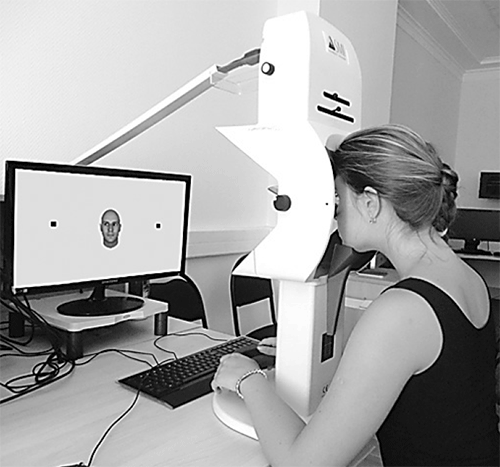
Fig. 1. Equipment for registering eye movements SMI iViewXTM Hi-Speed 1250
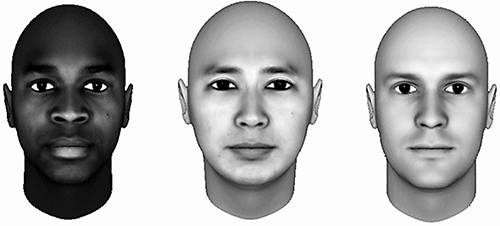
Fig. 2. Samples of distractor faces: African, Asian, Caucasian (European)
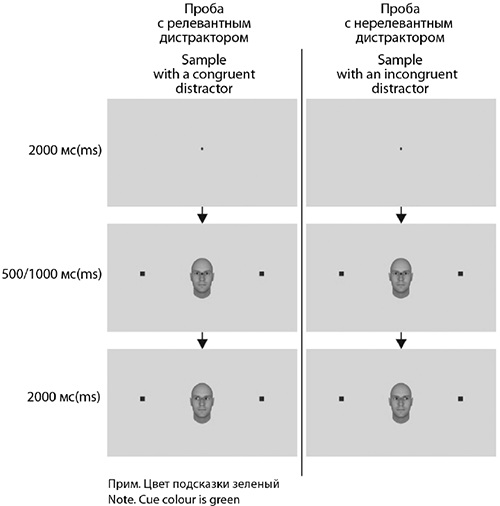
Fig. 3. Patterns of standard samples with relevant and irrelevant distractors [1]
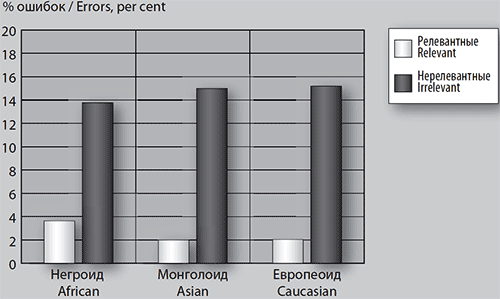
Fig. 4. Percentage of errors of the glance direction [2]
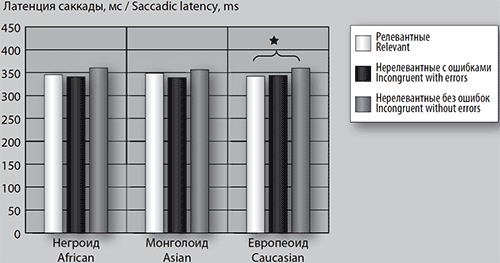
Fig. 5. Average latency of the saccade [3]
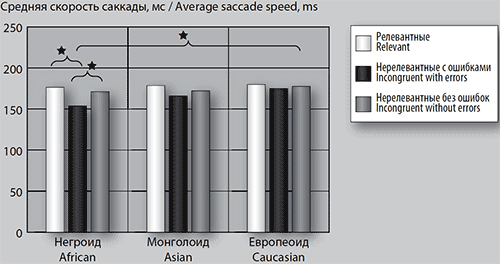
Fig. 6. Average speed of saccades [4]
Table 1. Mean value of errors (M) and standard deviations (SD) of the variable "Number of erroneous glances" (per cent)
|
Race of distractor face |
Congruent |
Incongruent |
||
|
M |
SD |
M |
SD |
|
|
African |
3.6 |
3.1 |
14.3 |
12.7 |
|
Asian |
2.1 |
1.9 |
14.7 |
9.4 |
|
Caucasian |
1,9 |
1,3 |
16,5 |
11,2 |
Table 2. Statistical indicators of the average number of errors in samples with distractor faces of different races
|
|
Congruent |
Incongruent |
|
African -Asian |
Z=1.028 p=0.304 |
Z=0.665 p=0.506 |
|
African -Caucasian |
Z=1.504 p=0.132 |
Z=0.934 p=0.350 |
|
Asian-Caucasian |
Z=0.090 p=0.928 |
Z=0.302 p=0.763 |
Table 3. Mean values (M) and standard deviations (SD) of the variable "Saccadic Latency"
|
Race of distractor face |
Congruent |
Incongruent with errors |
Incongruent without errors |
|||
|
M |
SD |
M |
SD |
M |
SD |
|
|
African |
345.5 |
68.8 |
340.9 |
87.4 |
360.4 |
86.0 |
|
Asian |
348.7 |
59.9 |
339.0 |
54.0 |
356.5 |
66.1 |
|
Caucasian |
341.9 |
58.6 |
343.8 |
76.8 |
359.6 |
67.6 |
Table 4. Mean values (M) and standard deviations (SD) of the variable "Saccade speed"
|
Race of distractor face |
Congruent |
Incongruent with errors |
Incongruent without errors |
|||
|
M |
SD |
M |
SD |
M |
SD |
|
|
African |
176.4 |
18.1 |
153.8 |
33.5 |
171.2 |
18.6 |
|
Asian |
178.6 |
17.1 |
166.0 |
32.9 |
172.2 |
19.1 |
|
Caucasian |
179.9 |
21.3 |
175 |
24.8 |
177.6 |
23.6 |
Notes:
1. Left bar: the fixation point changes colour to green; according to the instruction the participant must change to leftward, the gaze cue in the distractor face is also leftward. Right bar: the fixation point changes colour to green, but the gaze cue in the distractor face is also rightw ard.
2. Left bars correspond to probes with the congruent gaze cue of the distractor face, right correspond to probes with the incongruent gaze cue of the distractor face.
3. On the abscissa axis there are groups of stimuli containing distractor faces of different races. The ordinate axis represents the latency of the saccade, ms. Bars with horizontal shading represent congruent samples.
4. On the abscissa axis there are groups of stimuli containing distractor faces of different races. The ordinate axis represents the values of the variable in angular degrees per second.
References:
Allison, T., McCarthy, G., Nobre, A.C., Puce, A., & Belger, A. (1994) Human extrastriate visual cortex and the perception of faces, words, numbers, and colors. Cerebral Cortex, 5, 544–554. doi: 10.1093/cercor/4.5.544
Bahill, A.T., Clark, M.R., & Stark, L. (1975) The main sequence: a tool for studying human eye movements. Mathematical Biosciences, 24, 191–204. doi: 10.1016/0025-5564(75)90075-9
Barabanshchikov, V.A., & Ananyeva, K.I. (2009) Perception of photo images of people of different race. [Vestnik RUDN], 1, 7-13.
Baron-Cohen, S., Wheelwright, S., Skinner, R., Martin, J., & Clubley, E. (2001) The Autism-Spectrum Quotient (AQ): Evidence from Asperger syndrome/high functioning autism, males and females, scientists and mathematicians. Journal of Autism & Developmental Disorders, 31(1), 5–17. doi: 10.1023/A:1005653411471
Bayliss, A.P., Pellegrino, G., & Tipper, S.P. (2005) Sex differences in eye gaze and symbolic cueing of attention. The Quarterly Journal of Experimental Psychology, 58 (4), 631–650. doi: 10.1080/02724980443000124
Becker, M.W. (2010) The effectiveness of a gaze cue depends on the facial expression of emotion: Evidence from simultaneous competing cues. Attention, Perception & Psychophysics, 72(7), 1814–1824. doi: 10.3758/APP.72.7.1814
Blais, C., Jack, R.E., Scheepers, C., Fiset, D., & Caldara, R. (2008) Culture shapes how we look at faces. PLoS One, 3(8), e3022. doi: 10.1371/journal. pone.0003022
Blascovich, J., Loomis, J., Beall, A. C., Swinth, K., Hoyt, C., & Bailenson, J.N. (2002) Immersive virtual environment technology as a methodological tool for social psychology. Psychological Inquiry, 13(2), 103–124. doi: 10.1207/S15327965PLI1302_01
Bothwell, R.K., Brigham, J.C., & Malpass, R.S. (1989) Cross-racial identification. Personality and Social Psychology Bulletin, 15, 19–25. doi: 10.1177/0146167289151002
Brigham, J.C., & Malpass, R.S. (1985) The role of experience and context in the recognition of faces of own- and other-race persons. Journal of social issues, 4, 139–155. doi: 10.1111/j.1540-4560.1985.tb01133.x
Chen-Harris, H., Joiner, W.M., Ethier, V., Zee, D.S., & Shadmehr, R. (2008) Adaptive Control of Saccades via Internal Feedback. J Neurosci, 28, 2804– 2813. doi: 10.1523/JNEUROSCI.5300-07.2008
Corkum, V., & Moore, C. (1995) Development of joint visual attention in infants. Joint attention: Its origins and role in development. Hillsdale, NJ: Erlbaum, 61–83.
Dalmaso, M., Galfano, G., & Castelli, Lи (2015) The impact of Same- and Other-Race gaze distractors on the control of saccadic eye movements. Perception, 44(8-9), 1020–1028. doi: 10.1177/0301006615594936
Deaner, R.O., Shepherd, S.V., & Platt, M.L. (2007) Familiarity accentuates gaze cueing in women but not men. Biol. Lett, 3, 64–67. doi: 10.1098/ rsbl.2006.0564
Dodd, M.D., Hibbing, J.R., & Smith, K.B. (2011) The politics of attention: gaze-cuing effects are moderated by political temperament. Atten. Percept. Psychophys, 73(1), 24–29. doi: 10.3758/s13414-010-0001-x
van Donkelaar, P., Siu, K.C., & Walterschied, J. (2004) Saccadic output is influenced by limb kinetics during eye-hand coordination. J. Mot. Behav, 36, 245–252. doi: 10.3200/JMBR.36.3.245-252
Driver, J., Davis, G., Ricciardelli, P., Kidd, P., Maxwell, E., & Baron-Cohen, S. (1999) Gaze perception triggers reflexive visuospatial orienting. Visual Cognition, 6, 509–540. doi: 10.1080/135062899394920
Friesen, C.K., & Kingstone, A. (1998) The eyes have it! Reflexive orienting is triggered by nonpredictive gaze. Psychonomic Bulletin & Review, 5, 490–495. doi: 10.3758/BF03208827
Fu, G., Hu, C.S., Wang, Q., Quinn, P.C., & Lee, K. (2012) Adults scan own- and other-race faces differently. PloS One, 7(6), e37688. doi: 10.1371/journal. pone.0037688
Hirose, Y., & Peter, J.B. Equally attending but still not seeing: An eye-tracking study of change detection in own and other race faces. Retrieved from: http://www.psychologicalscience.com/2008/10/eyetracking-study.html ,doi: 10.1080/13506280601069578
Holmes, A., Richards, A., & Green, S. (2006) Anxiety and sensitivity to eye gaze in emotional faces. Brain and cognition, 60, 282–294. doi: 10.1016/j. bandc.2005.05.002
Humphreys, G., Hodsoll, J., & Campbell, C. (2005) Attending but not seeing: The “other race” effect in face and person perception studied through change blindness. Visual Cognition, 12(1), 249–262. doi: 10.1080/13506280444000148
Hungr, C.J., & Hunt, A.R. (2012) Physical Self-Similarity Enhances the Gaze Cueing Effect. The Quarterly Journal of Experimental Psychology, 65(7), 1250–1259. doi: 10.1080/17470218.2012.690769
Jones, B.C., DeBruine, L.M., Main, J.C., Little, A.C., Welling, L.L., Feinberg, D.R., & Tiddeman, B.P. (2010) Facial cues of dominance modulate the short-term gaze-cuing effect in human observers. Proceeding of the Royal Society B: Biological Sciences, 277, 617–624. doi: 10.1098/rspb.2009.1575
Kharitonov, A.N., & Ananyeva, K.I. (2012) Face recognition and the effect of «another race». [Litso cheloveka kak sredstvo obshcheniya: mezhdistsiplinarnyy podkhod]. Moscow, Kogito-tsentr, 145–160.
Kingstone, A., Smilek, D., Ristic, J., & Eastwood, J.D. (2003) Attention, researchers! It is time to take a look at the real world. Current Directions in Psychological Science, 12, 176–180. doi: 10.1111/1467-8721.01255
Kovalev, A., Menshikova, G., & Zinchenko, Y. (2016) Eye movements characteristics as indicators of ethno-cultural identity. International Journal of Psychophysiology, 108, 146. 10.1016/j.ijpsycho.2016.07.424
Kuhn, G., & Kingstone, A. (2009) Look away! Eyes and arrows engage oculomotor responses automatically. Attention, Perception & Psychophysics, 71, 314–327. doi: 10.3758/APP.71.2.314
Macdonald, R.G., & Tatler, B.W. (2013) The effect of social roles on gaze cue utilisation in a real-world collaboration. Proceedings of 35th Annual Cognitive Science Society Meeting (CogSci 2013). 942–947.
Meissner, C.A., & Brigham, J.C. (2001) Thirty years of investigating the own-race bias in memory for faces: A meta-analytic review. Psychology, Public Policy, & Law, 7, 3–35. doi: 10.1037/1076-8971.7.1.3
Menshikova, G.Ya., Saveleva, O.A., Zinchenko, Yu.P. (2016) Effects of interpersonal distance during interactions with avatars in virtual environments. International Journal of Psychophysiology, 108, 163. doi: 10.1016/j.ijpsycho.2016.07.467
Posner, M.I. (1980) Orienting of attention. Quarterly Journal of Experimental Psychology, 32, 3–25. doi: 10.1080/00335558008248231
Quadflieg, S., Mason, M.F., & Macrae, C.N. (2004) The owl and the pussycat: Gaze cues and visuospatial orienting. Psychonomic Bulletin & Review, 11(5), 826–831. doi: 10.3758/BF03196708
Ricciardelli, P., Bricolo, E., Aglioti, S., & Chilazzi, L. (2002) My eyes want to look where your eyes are looking: Exploring the tendency to imitate another individuals’ gaze. Neuroreport, 13, 2259–2264. doi: 10.1097/00001756-200212030-00018
Shepherd, S.V., Deaner, R.O., & Platt, M.L. (2006) Social status gates social attention in monkeys. Curr. Biol, 16, 119–120. doi: 10.1016/j.cub.2006.02.013
Snyder, L.H., Calton, J.L., Dickinson, A.R., & Lawrence, B.M. (2002) Eye-Hand Coordination: Saccades Are Faster When Accompanied by a Coordinated Arm Movement. J. Neurophysiol, 87, 2279–2286.
Süßenbach, F., & Schönbrodt, F. (2014) Not afraid to trust you: Trustworthiness moderates gaze cueing but not in highly anxious participants. Journal of Cognitive Psychology, 26, 670–678. doi: 10.1080/20445911.2014.945457
Takikawa, Y., Kawagoe, R., Itoh, H., Nakahara, H., & Hikosaka, O. (2002) Modulation of saccadic eye movements by predicted reward outcome. Exp Brain Res, 142, 284–291. doi: 10.1007/s00221-001-0928-1
Tipples, J. (2006) Fear and fearfulness potentiate automatic orienting to eye gaze. Cogn. Emotion, 20, 309–320. doi: 10.1080/02699930500405550
Wu, E. X., Laeng, B., & Magnussen, S. (2012) Through the eyes of the own-race bias: Eye-tracking and pupillometry during face recognition. Social Neuroscience, 7, 202–216. doi: 10.1080/17470919.2011.596946
Zinchenko, Yu.P., Kovalev, A.I., Menshikova, G.Ya., Shaigerova, L.A. (2015) Postnonclassical methodology and application of virtual reality technologies in social research. Psychology in Russia: State of the Art, 8(4), 60–71. doi: 10.11621/pir.2015.0405
For citing this article:
Menshikova G.Ya., Kovalev A.I., Luniakova E.G. (2017). Studying the influence of race on the gaze cueing effect using eye tracking method. National Psychological Journal. 2, 46-58.


